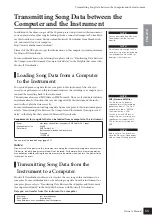
Detailed Settings – [FUNCTION]
Owner’s Manual
45
ENGLISH
About Each Function
You can fine tune the pitch of the entire instrument.
This function is useful when you play the instrument
along with other instruments or CD music.
1. Engage the Function mode and select
.
2. Use the [–/NO] and [+/YES] buttons to lower or
raise the pitch of the A3 key in approximately
0.2 Hz increments.
The value appears two-digit number and one decimal
place.
Ex. 440.2Hz is shown as 40.2 on the display.
You can select various scales.
Equal Temperament is the most common
contemporary piano tuning scale. However,
history has known numerous other scales,
many of which serve as the basis for certain
genres of music. You can experience these
tunings with the instrument.
Equal Temperament
One octave is divided into twelve equal intervals.
Currently the most popular piano tuning scale.
Pure Major/Pure Minor
Based on natural overtones, three major chords using
these scales produce a beautiful, pure sound.
Pythagorean
This scale, designed by Pythagoras, a Greek philosopher,
is based on the interval of a perfect 5th.
The 3rd produces swells, but the 4th and 5th are beauti-
ful and suitable for some leads.
Mean Tone
This scale is an improvement of the Pythagorean in that
the swell of the 3rd has been eliminated. The scale
became popular during the late 16th century through the
late 18th century, and was used by Handel.
Werckmeister/Kirnberger
These scales combine Mean Tone and Pythagorean in
different ways. With these scales, modulation changes the
impression and feel of the songs. They were often used in
the era of Bach and Beethoven. They are often used today
to reproduce the music of that era on harpsichords.
1. Engage the Function mode and select
.
2. Press the [+/YES] button to engage the scale
function’s sub-mode, then use the [TEMPO/
FUNCTION
▼
,
▲
] buttons to select the
desired sub-mode.
Press the [–/NO] and [+/YES] buttons to select
the number of the desired tuning.
Sub-mode
F2.1: Scale
Setting range:
1: Equal Temperament
2: Pure Major
3: Pure Minor
4: Pythagorean
5: Mean Tone
6: Werckmeister
7: Kirnberger
Normal setting:
1: Equal Temperament
F2.2: Base Note
If you select a scale other than Equal Temperament, you
need to specify the root. (You can specify the root note
with Equal Temperament selected, but it is not effective.
The base note setting is effective for tunings other than
the Equal Temperament tuning.)
Setting range:
Normal setting:
• Root indication example
F1. Fine Tuning of the Pitch
Display
Value
440.0
Setting range:
440.2
427.0 – 453.0 (Hz)
440.4
Normal setting:
440.6
440.0 (Hz)
440.8
TERMINOLOGY
Hz (Hertz):
This unit of measurement refers to the frequency of a sound and
represents the number of times a sound wave vibrates in a second.
F2. Selecting a Scale
(F
)
(G)
(A
)
followed by
a high bar if sharp
followed by
a low bar if flat






























